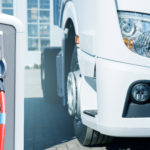EV Fleet for the Logistics Industry
Pollution – both local pollutants and global carbon emissions – are a growing cause for concern and heavy transport vehicles are a significant contributor. Noxious pollutants from diesel trucks directly affect the health of the community and the enjoyment of public space. Arresting this environmental and health damage is imperative and EV fleets offer hope.
Thus far, high energy requirements and low energy density of batteries have been a hindrance to the uptake of battery-electric trucks. However, recent developments in battery technology are making electric heavy-duty trucks viable, in large part due to reduced battery prices leading to decreased life cycle costs.
Perks of Fleet Electrification
Conscious of the damage to the environment, many auto manufacturers have committed to increase the number of electric options within their fleet. This, together with constantly improving battery densities are a cause of optimism for fleet owners.
Electric trucks can offer many benefits to fleet owners. To EV fleet owners that operate out of depots, electrifying their fleet and managing charging can provide significant savings in refueling costs. It is also possible to extend the life of an electric truck beyond what a fleet owner would consider for a diesel truck. By changing batteries and retrofitting the body, the holding periods of electric trucks could be higher than that of diesel trucks further driving down life cycle costs.
Globally, trucks contribute to 39% of the transport sector’s GHG emissions, and a total of 5% of all fossil fuel-derived carbon dioxide emissions. While currently, freight transport accounts for less than half of transport emissions, it is expected to grow by 56%−70% between 2015 and 2050, despite large improvements in energy efficiency. This is due to the expected increase in logistics demand associated with online shopping, increased urbanisation, and reduced car ownership. There is a strong focus on EV fleets worldwide, and IDTechEx forecasts the penetration of electric trucks into the global medium and heavy-duty market to be 9.4% by 2030.
- Environmental impacts – It has been estimated that worldwide, electric trucks will influence road freight emissions from 2035 onwards and account for one-third of the emission reductions in 2050.
- Public and driver health – Battery electric vehicles will improve public and driver health due to the lack of tailpipe emissions and reduced noise pollution.
- Lifetime costs – Even with higher purchasing costs compared to a diesel truck, electric freight vehicles are competitive if the annual driving distance is high enough and battery lifetime matches the vehicle lifetime.
Considerations for the electric logistics fleet
The main considerations when transitioning to an EV fleet are vehicle usage requirements i.e., what tasks does it need to fulfill, the load it is required to carry, the per-mission distance for range, and parking/off duty cycles for charging.
When considering an electric truck, EV fleet operators will need to consider:
- payload and tare weight
- upfront purchase costs, operating costs, and the total cost of ownership
- charging management
- fit for purpose model availability
- existing fleet duty cycles
- staff training including management and upskilling
- vehicle route optimisation
The Total Cost of Ownership (TCO)
TCO is an important consideration for commercial fleet owners. In the case of electric trucks, EV fleet owners would need to compare TCO across time by balancing a multitude of variables – battery size, battery degradation, duty cycles, operating, etc. At present, the purchase costs of electric trucks are much higher than diesel trucks and the operational savings occur over time. A meticulous estimation of the TCO of electric trucks would allow EV fleet owners to make wise economic choices.
TCO Quantification Parameters
Here’s a list of the most relevant cost components for the total cost of ownership calculation. The values can be combined with the following cost components in order to work out a unified total cost.
- Cost of purchasing the vehicle excluding the residual sale value
- Financing cost beyond retail price – cost of interest payments
- Fuelling – depending on the cost of electricity (energy and time of day), duty cycles, cost of diesel (for diesel trucks)
- Charging infrastructure and batteries for EV charging
- Insurance – Typical costs associated with insurance cover and vehicle replacement or repair
- Maintenance & repair – inspections, regular maintenance, scheduled part replacement, and unscheduled replacement of parts
- Taxes & fees – taxes paid on time of purchase, recurring annual costs, registration fees, parking, and tolls
- Payload capacity expenses – additional costs from adjustments in fleet vehicle operation due to the increased weight of new vehicle technologies
- Labor – typical wages and benefits for drivers, and costs for the time of charging and fuelling
Other costs specific to freight EV fleets include:
- Dead running costs – Excess mileages for trucks to recharge during operation (this includes both time based and distance based costs)
- Idling – In addition to fuel consumption required for core purposes, commercial vehicles also incur idling costs. The idle time spent in between the automotive duty cycles also contributes to the total costs.
- Payload capacity costs – Payload capacity costs can incur due to payload loss.
Charging the EV logistics fleet
Charging an electric truck will require the installation of charging infrastructure at depots (for back to base models) or along truck routes (for end-to-end models). The charging scheme required for electric trucks will depend on the operational scenarios for fleets, which include delivery routes and schedules.
Depot based charging
A depot-based charging model will see an electric truck start and end its route at the same place – making it possible to charge the electric truck while it is not in use. Many truck operations have defined cycles that permit off-cycle daily charging. A depot-based charging model ensures that charging infrastructure is an investment asset that gives the company control over site access, charger type, placement, and timing.There are different levels of charging stations that may be necessary for an electric truck fleet. The level of charging infrastructure will depend on each fleet’s duty cycles and route scheduling.
The depot based charging model is being more widely adopted in international markets.
On route charging
Fleets with variable routes and no guaranteed return trips require public fast-charging infrastructure to fulfil long-haul freight demands. This method of charging will become more important to satisfy heavy truck and long haul freight routes as technology for the sector develops. However, these use cases are minimal at this point in time.
Recent developments worldwide
In a bid to achieve carbon neutrality, businesses around the globe are taking advantage of disruptive technologies. Companies such as Amazon, British Gas, UPS, and FedEx are taking the lead in logistics fleet electrification. Falling costs, improved availability, and supportive policies help pave the way to a cleaner transport of the future.
Evenergi consulting for logistics
The transition to electric road freight transportation is gaining momentum, and companies can stay ahead of the game by being prepared for these changes. Evenergi can help freight and logistics companies seize opportunities and manage risks of an eMobility future through the development of economic and technical models to support the migration to electric logistics fleets.
Find out how Evenergi can help here.
Supporting Documentation
- https://www.sciencedirect.com/science/article/pii/S0306261918318361#b0025
- https://www.idtechex.com/en/research-report/electric-trucks-2020-2030/710
- https://nacfe.org/wp-content/uploads/2018/04/Electric_Trucks_Guidance_Report_Executive_Summary.pdf
- https://publications.anl.gov/anlpubs/2021/05/167399.pdf
- https://www.fleetowner.com/emissions-efficiency/article/21703545/the-returntobase-strategy-for-charging-electric-trucks
- IEA Global Outlook 2019

 An introduction to electric road freight vehicles
An introduction to electric road freight vehicles EV Fleet for Bus Operators
EV Fleet for Bus Operators EV Basics – EV Batteries
EV Basics – EV Batteries EV Fleet
EV Fleet